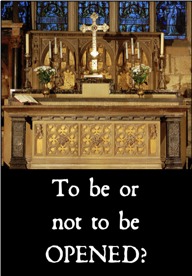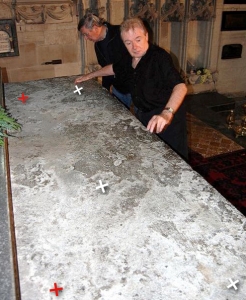
The Altar
The ultimate goal — the Holy of Holies.
It’s not giving much away to tell you that the three touchstones (Gravestone, Monument and Sonnets Dedication) that serve as our ‘way in’ to the beginning of this puzzle, are ultimately leading to the Holy of Holies altar stone in Shakespeare’s church. (You learned at The Mystery home page that the codes ultimately led me to radar scan the altar stone.) So as you play THE GAME you will learn that John Dee aligned three T’s (stand-ins for Th) with two Y’s (already recognized stand-ins for Th) within the very centre of the four-line doggerel verse on the grave.
In effect he created a Tau Cross crucifix out of the name Jesus with FIVE Th’s (or T’s – they’re interchangeable) forming the vertical stipes. It’s hard not to make the connection that the FIVE Th crosses of the stipes are intended to represent Christ’s FIVE stigmata wounds – which in turn are represented in Catholic altars by FIVE consecration crosses carved into the top surface of the mensa stone.

The Catholic Encyclopedia states specifically: “By a decree of the Council of Trent (Sess. XXII), Mass should not be celebrated in any place except a consecrated or blessed church (and)… Mass must be celebrated either on an altar which has been consecrated or on a consecrated altar-stone or portable altar (Rubr. Gen Miss., XX).”
In English Church Furniture, John Charles Cox and Alfred Harvey state that “English altars from the 12th cent. onwards were, as a rule, incised on the mensa with five crosses, namely, in the centre and at the four angles.”
In other words before an altar was officially sanctified as acceptable for celebrating Mass, a consecration ritual had to be performed by a bishop and the FIVE crosses carved into the four corners and centre of the altar’s mensa stone or ‘table’ – the flat surface upon which the sacrifice of Mass is offered. And it’s here that our story takes on almost mystical significance.
Many areas of the church were mutilated during the Reformation, as were most images considered idolatrous by the rampaging reformers. Only a few sacred artifacts escaped and undoubtedly the most important survivor was the pre-Reformation stone altar slab (or mensa) found hidden beneath the church floor in 1889 during a restoration project. Interestingly it was not found in the catacombs, seventeen feet below, but was tightly packed in earth just below the wooden floor on the south side of the nave. It was considered a providential discovery and was joyfully re-instated as the centerpiece of the church’s worshipful focus, the High Altar.

Measuring the altar stone. The cross markers (added to the picture) indicate the currently surviving crosses (white) and the two missing ones (red).
The historical record indicates that it would have been hidden underground ’round about 1535 when Henry VIII determined the country’s fate based on his desire for a new, child-bearing wife. Many years later Dee traveled the entire length and breadth of the country specifically looking for Catholic stones, monuments, artifacts, etc., as part of his effort to save the fast disappearing legacy of his own faith.
The carving and incensing of the five consecration crosses is an immensely important ritual and is accompanied by another just as crucial to the sanctification of all altar stones. This involves cutting a cavity into the stone and placing a saint’s relics (bones, hair, writings, whatever has been sent by Rome) into the resultant opening. It is then resealed by concreting the same stone that was cut out, back into place.
So herein lies the crux of why the radar scan is such important proof. The cavity created by the ritual just described is usually no bigger than a small child’s shoe box. The scan shows a cavity approximately 250x that size, with varying densities within it, revealing the presence of ‘something’ inside the huge cavity. And thus the ‘first level’ of encryptions has been conclusively proven correct.
However, the plot thickens…
